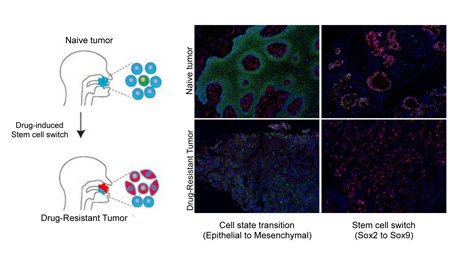A*STAR NEWS
PRESS RELEASES
Fighting cancer one cell at a time
Singapore – A team of scientists from Agency for Science- Technology and Research’s (A*STAR) Genome Institute of Singapore (GIS) has identified a new approach to cancer therapeutics by targeting the evolution of cancer cells. This approach prevents or delays the progression of cancer into treatment-resistant/metastatic disease. The study was published in Nature Communications on 22 November 2018.
The scientists discovered that cancer cells constantly evolve under the selection pressure of standard-of-care drugs. They identified two distinct survival strategies adopted by tumours – (1) 'playing dead' by turning dormant and (2) activating resistant or metastasis-associated genes (genes that cause the spread of cancer from the primary site). The study also found that cancer cells were able to change their epigenetic makeup in order to become resistant to drugs and other forms of treatment. Greater understanding of these mechanisms provides opportunities to target these processes that will help to prevent or delay the spread of cancer.
Traditional approaches to cancer treatment have primarily focused on complete elimination of cancer cells. They treat patients with high doses of chemotherapy to target the highly proliferative tumour cells. However- it is increasingly clear that like any other living being- cancer cells also follow the basic evolutionary principles and will adapt to survive.
This study employed single-cell genomics and patient-derived primary cell (PDPC) models to identify the different modes that cause cancer cells to become resistant or metastatic. The scientists observed that in some patients- the cancer cells kept multiplying even when treated with high doses of the drug. Researchers theorise that the cells were switching their stem cell factors upon treatment- making them drug resistant.
“The cancer cells behave like chameleons- altering their gene expression and cell behaviour to overcome drug treatment. A comprehensive understanding of tumour evolution and our ability to predict cancer’s next evolutionary move can serve as a way forward to manage therapy resistance in the clinic-” said Dr Ankur Sharma- first author of the study and Research Associate at GIS.
Dr Ramanuj DasGupta- senior author of the study and Group Leader at GIS- added- “Like a game of whack-a-mole- cancer cells have a long history of finding alternative routes to evade treatment. By targeting the tumour evolution itself- we aim to prevent or at least delay its progression- and at the same time- avoid the harsh effects of excessive treatment.”
Further investigations identified the BRD4 gene as a key molecule for resistance. They then treated the resistant cells with JQ1- a drug known to block BRD4 activity- and were able to reverse or delay drug-resistance in tumour cells.
Professor William Hwang- Medical Director at National Cancer Centre Singapore- said- “The findings could help us identify patients with cancer who are at the highest risk of having treatment-resistant relapse- as well as suggest some ways that we can better treat these patients when they relapse. We look forward to being able to translate this into clinical practice in the near future.”
Professor Ng Huck Hui- Executive Director at GIS- said- “Tumour cells are constantly evolving. We need to adopt new strategies of evolutionary precision medicine to target them with the right drugs. Targeting the cancer’s evolution itself has the potential to convert this dreaded disease into something that can be chronically managed- and this study is the first step towards that goal.”

Drug-induced stem-cell switch (from Sox2 to Sox9) activates epigenetic re-programming driving tumour evolution in squamous cell carcinomas.
(Copyright: A*STAR’s Genome Institute of Singapore)
About A*STAR’s Genome Institute of Singapore (GIS)
The Genome Institute of Singapore (GIS) is an institute of the Agency for Science- Technology and Research (A*STAR). It has a global vision that seeks to use genomic sciences to achieve extraordinary improvements in human health and public prosperity. Established in 2000 as a centre for genomic discovery- the GIS will pursue the integration of technology- genetics and biology towards academic- economic and societal impact.
The key research areas at the GIS include Human Genetics- Infectious Diseases- Cancer Therapeutics and Stratified Oncology- Stem Cell and Regenerative Biology- Cancer Stem Cell Biology- Computational and Systems Biology- and Translational Research.
The genomics infrastructure at the GIS is utilised to train new scientific talent- to function as a bridge for academic and industrial research- and to explore scientific questions of high impact.
For more information about GIS.
About the Agency for Science- Technology and Research (A*STAR)
The Agency for Science- Technology and Research (A*STAR) is Singapore's lead public sector agency that spearheads economic oriented research to advance scientific discovery and develop innovative technology. Through open innovation- we collaborate with our partners in both the public and private sectors to benefit society.
As a Science and Technology Organisation- A*STAR bridges the gap between academia and industry. Our research creates economic growth and jobs for Singapore- and enhances lives by contributing to societal benefits such as improving outcomes in healthcare- urban living- and sustainability.
We play a key role in nurturing and developing a diversity of talent and leaders in our Agency and research entities- the wider research community and industry. A*STAR’s R&D activities span biomedical sciences and physical sciences and engineering- with research entities primarily located in Biopolis and Fusionopolis.
Was This Article Helpful?
A*STAR celebrates International Women's Day

From groundbreaking discoveries to cutting-edge research, our researchers are empowering the next generation of female science, technology, engineering and mathematics (STEM) leaders.
Get inspired by our #WomeninSTEM
